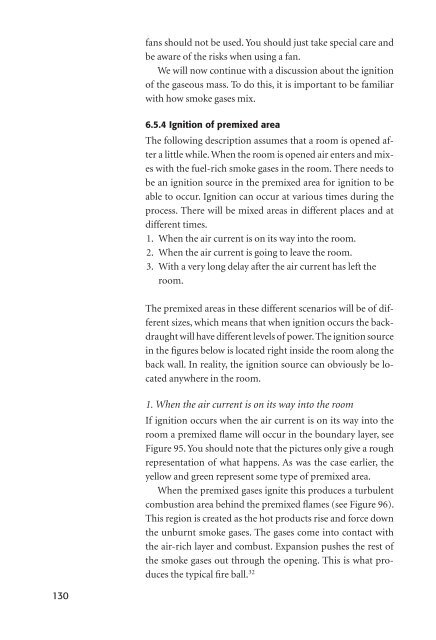You also want an ePaper? Increase the reach of your titles
YUMPU automatically turns print PDFs into web optimized ePapers that Google loves.
130<br />
fans should not be used. You should just take special care and<br />
be aware of the risks when using a fan.<br />
We will now continue with a discussion about the ignition<br />
of the gaseous mass. To do this, it is important to be familiar<br />
with how smoke gases mix.<br />
6.5.4 Ignition of premixed area<br />
The following description assumes that a room is opened after<br />
a little while. When the room is opened air enters and mixes<br />
with the fuel-rich smoke gases in the room. There needs to<br />
be an ignition source in the premixed area for ignition to be<br />
able to occur. Ignition can occur at various times during the<br />
process. There will be mixed areas in different places and at<br />
different times.<br />
1. When the air current is on its way into the room.<br />
2. When the air current is going to leave the room.<br />
3. With a very long delay after the air current has left the<br />
room.<br />
The premixed areas in these different scenarios will be of different<br />
sizes, which means that when ignition occurs the backdraught<br />
will have different levels of power. The ignition source<br />
in the fi gures below is located right inside the room along the<br />
back wall. In reality, the ignition source can obviously be located<br />
anywhere in the room.<br />
1. When the air current is on its way into the room<br />
If ignition occurs when the air current is on its way into the<br />
room a premixed fl ame will occur in the boundary layer, see<br />
Figure 95. You should note that the pictures only give a rough<br />
representation of what happens. As was the case earlier, the<br />
yellow and green represent some type of premixed area.<br />
When the premixed gases ignite this produces a turbulent<br />
combustion area behind the premixed fl ames (see Figure 96).<br />
This region is created as the hot products rise and force down<br />
the unburnt smoke gases. The gases come into contact with<br />
the air-rich layer and combust. Expansion pushes the rest of<br />
the smoke gases out through the opening. This is what produces<br />
the typical fi re ball. 32

















